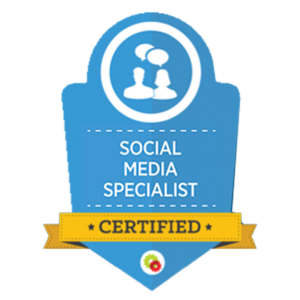MARKETING
2 Ways to Take Back the Power in Your Business: Part 1


As I considered the topic that would best serve entrepreneurs, business owners, and marketers alike — all of whom I am — I mused over what I needed most throughout the last year.
I needed to take back control of my business.
And I am charging you to do the same.
While I have provided two strategic ways to do so, the first outlined below and the second outlined in this blog post, it is critical that we first identify the root issue.
Why are you and I not operating in the driver’s seat of our marketing and/or businesses?
Three fundamental core challenges come in the form of 3 Cs: Competition, Colleagues, and Customers.
Who Are You Listening To?
1. Competition
We know the feeling all too well.
We feel a pit in our stomach or a slight racing of the heart when our competitors’ ads or organic content seem to be taking over social media and the internet: Google Ads, YouTube, TikTok, newsletters, LinkedIn, programmatic…
And don’t forget traditional advertising.
Especially if you are in the home services or specialty services spaces where direct mail is 100% where you need to be, but don’t forget the QR code and UTMs and unique landing pages and geotargeted ads and email nurturing sequence for a holistic approach.
Our competition’s budget appears never-ending, and their marketing team must be fantastic.
Is theirs the strategy we should adopt, deviating from our carefully charted course agreed upon at the outset of the year?
2. Colleagues
Or perhaps it’s that of the peers in our Masterminds or networking groups or online communities.
After all, within these groups resides a wealth of knowledge and expertise, tried-and-true insights, and wins. I am guilty as charged — my talk at T&C 2024 was chock-full of recommendations guiding marketers on their path to generating over 800% ROAS…
Should our marketing strategy or business’s bottom line deviate then?
3. Customers
Oh! But the power of our customers…when their phone call just after 5:00 PM because they saw their competitor’s ad and want to change course.
Or when our customers’ higher-ups ask why you didn’t generate enough leads last month and how the bottom line is threatened if we don’t do something fast.
And how they joke about your job being on the line if numbers don’t change.
Do any of these resonate?
If you are a human with a soul that cares about your business, team, and customers, I anticipate your hand is raised alongside mine.
Friends, it is time we unbuckle the seatbelt of the 3 Cs and graciously escort them out.
It’s time for you to regain control.
How to Regain Control of Your Business: Knowing What You Want
I cannot tell you how many times my question, “What do you want?” is met with blank stares.
Such a simple question with such significant ramifications.
To assume control, we must know what we want for the following three reasons.
1) Knowing what you want keeps you focused on the bottom line.
So many of us fail to regularly take stock of where we are actually going.
Our heads are down, focused on tasks before us, rather than heads up, looking to the finish line yet equally aware of how our strategies today are or are not moving us closer to that target.
With our heads down, the focus is on the key performance indicators (KPIs) of the necessary activations to achieve the bottom-line goal rather than the focus being on the goal itself.
The trick is maintaining clarity of the goal and bottom line to then inform the strategic direction.
EXAMPLE: The Knowing Agency serves as fractional CMO for a waterproofing company. A major — colossal, even — KPI is lead generation.
This KPI is obviously important because you need leads to get customers.
However, in 2023, our lead count was down significantly.
With the 3 Cs close at hand, I questioned myself: Am I leading the team in the wrong direction!?
We must be willing to ask tough questions and pursue the truth, even if it may prove that we are heading in the wrong direction — especially then!
For we must first know the truth to then be changed by it.
But I had to zoom out in order to know.
With the bottom line as the primary focus, I then considered the KPI.
When we zoomed out and measured that KPI in light of the bottom line, revenue, rather than as a standalone metric, we actually saw a significant increase in overall revenue and profits despite a lower lead count.
This means that while we were driving fewer leads, they were much more qualified, hence driving higher revenue.
My question for you is: Do you know what you want?
And do you know your bottom line goal and the KPIs necessary to get there?
2) Knowing what you want protects you from the 3 Cs.
The bottom-line goals of your company or department serve as guardrails to keep you on the straight and narrow when one of the 3 Cs comes calling.
Protection from Competitors: Their bottom line could very well be entirely different from yours. Perhaps you seek to expand into a new region and must allocate funds by cutting budgets on top-of-funnel brand awareness tactics. Yet your competitor is dominating TV. Don’t deviate; your bottom line is at stake.
Protection from Colleagues: Perhaps your bottom line is similar, but your target audiences are different. They are finding wild success with newsletters reaching an older demo while your audience is highly engaged with podcasts. Yes, perhaps explore newsletters, but not at the expense of your engaged audience on your podcast.
Protection from Customers: Hopefully, you both have the same bottom line! However, when my client called with concerns about the KPI of lead numbers, which is indeed important, my ability to maintain focus on the bottom line guided their right thinking about what matters most: Revenue.
Protection from the 3 Cs does not mean turning a blind eye or ignoring what is working for them. But it does keep your bottom line as the chief focus.
3) Knowing what you want protects you from running on auto-pilot.
Knowing what you want maintains momentum and breathes energy into tasks that otherwise would be monotonous.
Lead yourself or your team in revisiting the vision for the company regularly.
Nine-to-five employees increasingly seek to align with impact-driven organizations, and keeping the transformation the company aims to procure top-of-mind will drive motivation.
The transformation is always emotional, even surrounding a product or service.
EXAMPLE: Returning to the waterproofing company our team supported. Waterproofing a basement transforms the customers’ emotional states from one of anxiety or worry into one of peace or assurance.
What once was: We are a waterproofing company servicing homeowners in Destin, Florida, for 54 years. Trust our team to waterproof your basement!
Turns into: Our company cares for your family. Our company preserves homeowners’ greatest investment. Our company, ultimately, protects your home, which is where life happens.
Suddenly, a waterproofing company has empathy.
Just like that, we are serving families and homes, not just servicing a basement.
But before you can truly know what you want, you first have to know who you are.
Head on over to Part 2! (Coming soon…)
MARKETING
Quiet Quitting vs. Setting Healthy Boundaries: Where’s The Line?

MARKETING
Microsoft unveils a new small language model

Phi-3-Mini is the first in a family of small language models Microsoft plans to release over the coming weeks. Phi-3-Small and Phi-3-Medium are in the works. In contrast to large language models like OpenAI’s ChatGPT and Google’s Gemini, small language models are trained on much smaller datasets and are said to be much more affordable for users.
We are excited to introduce Phi-3, a family of open AI models developed by Microsoft. Phi-3 models are the most capable and cost-effective small language models (SLMs) available, outperforming models of the same size and next size up across a variety of language, reasoning, coding and math benchmarks.
What are they for? For one thing, the reduced size of this language model may make it suitable to run locally, for example as an app on a smartphone. Something the size of ChatGPT lives in the cloud and requires an internet connection for access.
While ChatGPT is said to have over a trillion parameters, Phi-3-Mini has only 3.8 billion. Sanjeev Bora, who works with genAI in the healthcare space, writes: “The number of parameters in a model usually dictates its size and complexity. Larger models with more parameters are generally more capable but come at the cost of increased computational requirements. The choice of size often depends on the specific problem being addressed.”
Phi-3-Mini was trained on a relatively small dataset of 3.3 trillion tokens — instances of human language expressed numerically. But that’s still a lot of tokens.
Why we care. While it is generally reported, and confirmed by Microsoft, that these SLMs will be much more affordable than the big LLMs, it’s hard to find exact details on the pricing. Nevertheless, taking the promise at face-value, one can imagine a democratization of genAI, making it available to very small businesses and sole proprietors.
We need to see what these models can do in practice, but it’s plausible that use cases like writing a marketing newsletter, coming up with email subject lines or drafting social media posts just don’t require the gigantic power of a LLM.
Dig deeper: How a non-profit farmers market is leveraging AI
MARKETING
Navigating the Video Marketing Maze: Short-Form vs. Long-Form


Are you torn between using long-form or short-form videos for your small business marketing campaign? Well, you are not alone. Despite 89% of consumers wanting to see more brand videos, there is no one-size-fits-all answer about the ideal video length.
However, this should not deter you from creating an effective video strategy. In 2023, people watched an average of 17 videos per day, highlighting the influence of video content in today’s digital landscape.


Both short-form and long-form videos offer unique advantages and come with their set of challenges. Join me as I uncover the benefits and limitations of each video format to help you make informed marketing decisions.
What are Short-Form Videos?
Short videos typically range from 30 seconds to less than 10 minutes long. They are popular on social media platforms like TikTok, Instagram, Snapchat, and YouTube.
Short-form videos deliver brief yet engaging messages that quickly capture the viewer’s attention. Here are some popular types of short-form video content.
- TikTok Challenges
- Instagram Reels
- Snapchat Stories
- YouTube Shorts
- Twitter Video Ads
Benefits of Short-Form Videos
A previously cited report shows that 39% of marketers find short-form videos, ranging from 30-60 seconds long, more successful. The same study reports that 44% of customers prefer watching a short video to learn about a brand’s offerings.


So, it is evident that short-form videos have their benefits. Let’s take a closer look at some of them.
Attention-Grabbing
Short-form videos capture attention quickly, making them ideal for the fast-scrolling nature of social media platforms. Your audience is more likely to watch them in their entirety compared to longer content.
Cost-Effective Production
Creating short-form videos requires less time and resources compared to longer videos. As a small business owner with a limited budget, using short-form videos can be cost-effective.
Increased Engagement
Short-form videos engage viewers due to their crisp and concise nature. This results in more likes, comments, and shares that boost your content’s visibility and increase brand awareness.
Integrating short-form videos into your influencer marketing campaigns can further amplify your reach to new and diverse audiences.
Highly Shareable
Short videos are highly shareable. This makes it more likely for your viewers to share them, increasing their virality.


Want to get certified in Content Marketing?
Leverage the tools and channels to predictably and profitably drive awareness, leads, sales, and referrals—EVERYTHING you need to know to become a true master of digital marketing. Click Here
There are multiple benefits of adding video to your website including increased engagement, improved SEO, and enhanced user experience.
Limitations of Short-Form Videos
While short-form videos offer many advantages in content marketing, they also present some challenges.
Limited Message Depth
Due to their brief duration, short-form videos may struggle to convey complex or detailed messages. Longer videos might be more suitable if you need to communicate intricate information.
Competition for Attention
Standing out on platforms flooded with short-form video content can be challenging. You must create content that stands out to avoid becoming lost in the sea of other videos.
Shorter Lifespan
Short videos may lose their relevance with time. They can quickly get buried in users’ feeds, leading to a shorter visibility and engagement period than longer, evergreen content.
This means you must consistently create short-form videos to maintain audience interest over time.
Limited SEO Impact
Short-form videos may be more challenging to optimize for search engines than longer, more keyword-rich content. This can affect the discoverability of your content outside the social media scene.
What are Long-Form Videos?
Long-form videos are typically longer, ranging from a few minutes to several hours. They extend beyond a few minutes to several hours, providing ample time for in-depth topic exploration and detailed content.
These videos are particularly suitable for educational content, product demonstrations, and narrative-driven storytelling. Long-form videos are common on platforms like YouTube and Vimeo. Common types of long-form video content include:
- YouTube Series
- Webinars
- Educational Tutorials and Courses:
- Behind-the-Scenes Content
- Interviews and Conversations
Advantages of Long-Form Videos
Long-form video content is the fastest-growing segment, with videos above 30 minutes experiencing tremendous growth over the years. Let’s explore some of the benefits behind this growth.


Establishes Expertise and Credibility
Long-form videos allow you to provide in-depth information about various subjects, establishing your brand as an authority. Potential customers will likely trust and rely on your insights when you consistently deliver valuable content.
Builds Strong Audience Connections
The more your audience watches your videos, the more they become familiar with your content and brand. This consistent engagement promotes trust and loyalty, helping you create deeper connections with your audience.
Provide SEO Optimization Opportunities
Long-form videos keep your audience engaged for a longer duration than short ones. This signals search engines that your content provides value, resulting in higher rankings and increased visibility.
Besides, these videos provide opportunities to optimize for relevant keywords. This Attrock guide offers more insights into the value of SEO for your small business.
They Are Sustainable
Unlike short videos, well-produced and valuable long-form videos have an extended shelf life. They can continue to attract views and engagement over an extended period, contributing to a sustainable content strategy.
Instagram reels are also a part of short videos and you can get benefits from this platform by integrating it with your website. You can learn how to embed Instagram Reels on websites and get extra benefits from your Reels.
Drawbacks of Long-Form Videos
Despite their benefits, long-form videos also have certain limitations, including:
Attention Span Challenges
Between distractions, juggling tasks, and information overload, user attention span quickly diminishes. Viewers may lose interest and disengage from your long video before its conclusion.


Are You Ready to Master Social Media?
Become a Certified Social Media Specialist and learn the newest strategies (by social platform) to draw organic traffic to your social media sites.
Complex Production Process
Creating high-quality long-form videos requires more resources, including time, equipment, and skilled personnel. This can be disadvantageous, especially for small businesses with limited budgets.
Platform Limitations
Some social media platforms and video hosting sites may limit video length, making it challenging to distribute long-form video content. You may then be forced to repurpose your content to suit various platforms.
Short-Form or Long-Form Videos: Which Are Better?
Now that you know the benefits and limitations of each format, which one should you choose? Short-form or long-form videos?
Well, it all boils down to considering several factors, such as:
Content Objectives
What do you want to achieve from your video marketing campaign? Short-form videos are highly effective for quick brand exposure and generating buzz. Long-form videos, on the other hand, contribute to a more in-depth understanding of the brand.
Target Audience Preferences
Audiences with short attention spans likely prefer short-form videos, while long-form videos appeal to those seeking a more immersive experience.
Similarly, short-form videos may appeal more to younger audiences, while older demographics may prefer the depth of long-form content.
Platform Dynamics
Various platforms support different content formats. Short-form videos are well-suited for platforms like TikTok, Instagram, and Snapchat. On the other hand, platforms like YouTube and Vimeo are better for hosting longer videos.
Industry Type
Short-form videos would be ideal if your industry thrives on trends, entertainment, and quick messages. However, long-form videos are effective for industries requiring in-depth explanations or educational content.
Bottom Line
Ultimately, choosing short-form or long-form videos depends on your business’s specific needs and goals. Since both formats have advantages and limitations, making a choice may prove difficult.
However, it doesn’t have to be an uphill task. The key lies in recognizing when to incorporate each video format into your marketing strategy. Understanding your audience and its needs allows you to combine both formats strategically, maximizing the benefits of each.
Continuously analyze performance metrics and adapt your video marketing strategy accordingly to ensure optimal engagement and conversion rates.
-

 MARKETING6 days ago
MARKETING6 days agoEffective Communication in Business as a Crisis Management Strategy
-

 SEARCHENGINES6 days ago
SEARCHENGINES6 days agoGoogle Won’t Change The 301 Signals For Ranking & SEO
-

 SEO5 days ago
SEO5 days agobrightonSEO Live Blog
-

 PPC6 days ago
PPC6 days ago9 Ecommerce Trends to Boost Your Business in 2024
-

 SEO6 days ago
SEO6 days agoHow To Write ChatGPT Prompts To Get The Best Results
-

 SEO4 days ago
SEO4 days agoGoogle March 2024 Core Update Officially Completed A Week Ago
-
SEARCHENGINES5 days ago
Daily Search Forum Recap: April 25, 2024
-

 WORDPRESS4 days ago
WORDPRESS4 days ago9 Best WooCommerce Multi Vendor Plugins (Compared)
















